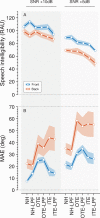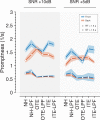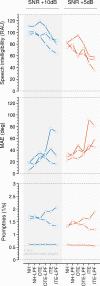The effects of hearing protection devices on spatial awareness in complex listening environments
- PMID: 36634110
- PMCID: PMC9836314
- DOI: 10.1371/journal.pone.0280240
The effects of hearing protection devices on spatial awareness in complex listening environments
Abstract
Hearing protection devices (HPDs) remain the first line of defense against hazardous noise exposure and noise-induced hearing loss (NIHL). Despite the increased awareness of NIHL as a major occupational health hazard, implementation of effective hearing protection interventions remains challenging in at-risk occupational groups including those in public safety that provide fire, emergency medical, or law enforcement services. A reduction of situational awareness has been reported as a primary barrier to including HPDs as routine personal protective equipment. This study examined the effects of hearing protection and simulated NIHL on spatial awareness in ten normal hearing subjects. In a sound-attenuating booth and using a head-orientation tracker, speech intelligibility and localization accuracy were collected from these subjects under multiple listening conditions. Results demonstrate that the use of HPDs disrupts spatial hearing as expected, specifically localization performance and monitoring of speech signals. There was a significant interaction between hemifield and signal-to-noise ratio (SNR), with speech intelligibility significantly affected when signals were presented from behind at reduced SNR. Results also suggest greater spatial hearing disruption using over-the-ear HPDs when compared to the removal of high frequency cues typically associated with NIHL through low-pass filtering. These results are consistent with reduced situational awareness as a self-reported barrier to routine HPD use, and was evidenced in our study by decreased ability to make accurate decisions about source location in a controlled dual-task localization experiment.
Copyright: © 2023 Snapp et al. This is an open access article distributed under the terms of the Creative Commons Attribution License, which permits unrestricted use, distribution, and reproduction in any medium, provided the original author and source are credited.
Conflict of interest statement
The authors have declared that no competing interests exist.
Figures





References
-
- Centers for Disease Control and Prevention C. National Occupational Research Agenda. National Institute for Occupational Safety and Health: DHHS (NIOSH) Publication Number; 96–115; 2014.
Publication types
MeSH terms
Grants and funding
LinkOut - more resources
Full Text Sources
Medical

